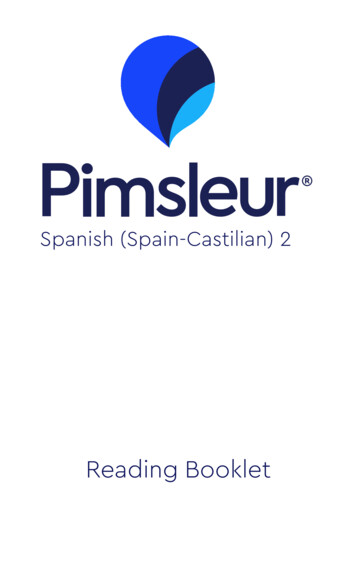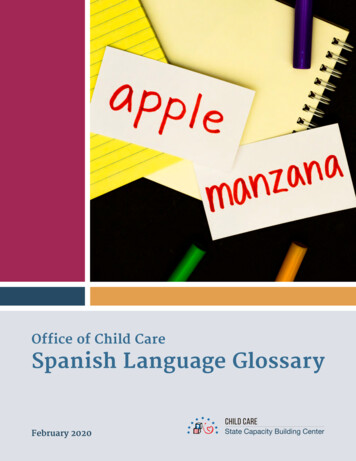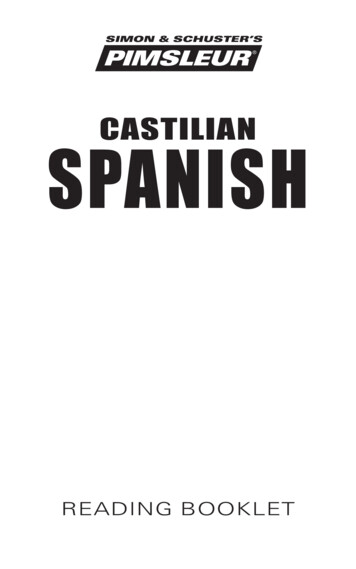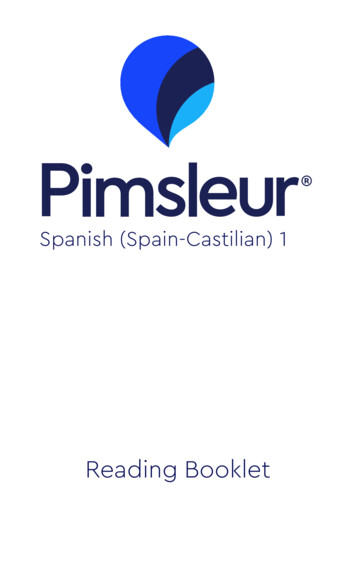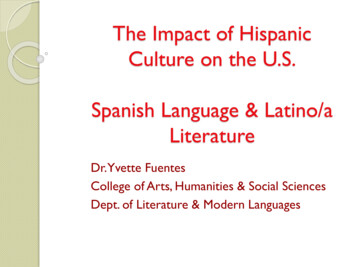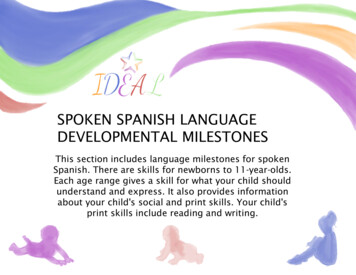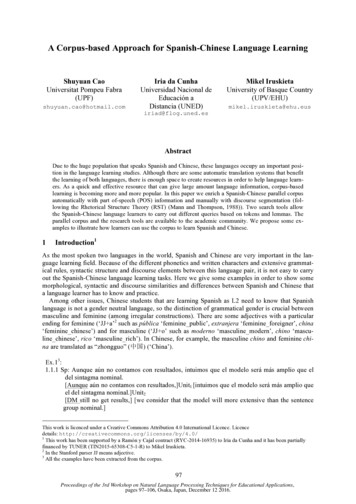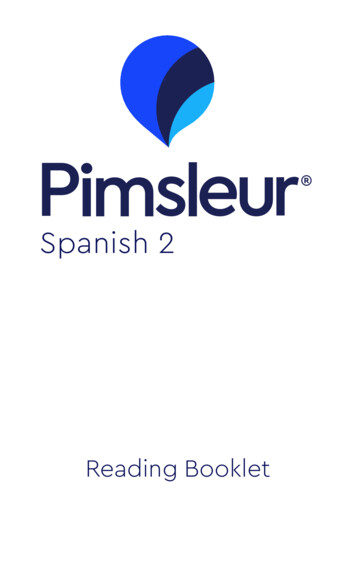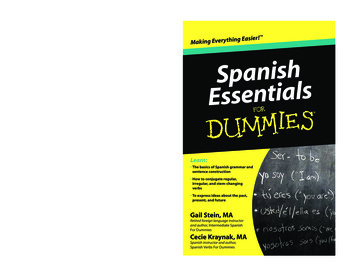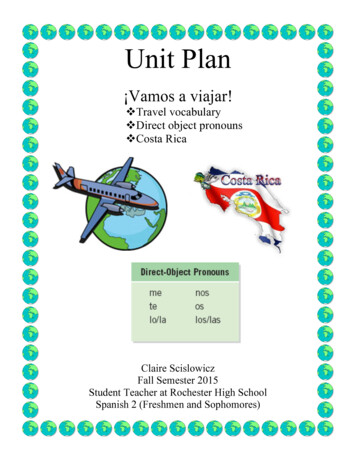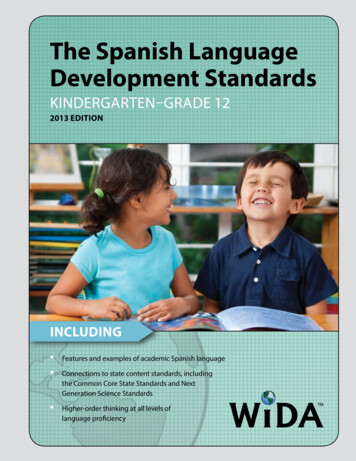
Transcription
The Spanish LanguageDevelopment StandardsKINDERGARTEN–GRADE 122013 EDITIONINCLUDING Features and examples of academic Spanish languageConnections to state content standards, includingthe Common Core State Standards and NextGeneration Science StandardsHigher-order thinking at all levels oflanguage proficiency
The Spanish LanguageDevelopment StandardsKINDERGARTEN–GRADE 122013 EDITION
Copyright NoticeWIDA’s Spanish Language Development Standards, Kindergarten through Grade 12, 2013 Edition (“WIDASLD Standards”) are owned by the Board of Regents of the University of Wisconsin System on behalfof WIDA. The WIDA SLD Standards are protected by United States copyright laws and may not bereproduced, modified, or distributed, including re-posting on the internet, without the prior writtenpermission of the Wisconsin Center for Education Research (WCER) and the Board of Regents of theUniversity of Wisconsin System. The WIDA SLD Standards are for your personal, noncommercial useonly. You may not alter or remove any trademark, copyright or other notice from copies of this booklet.Fair use of the WIDA SLD Standards includes reproduction for the purpose of teaching (includingmultiple copies for lesson/curricular planning). If you are not sure whether your use of this booklet andthe WIDA SLD Standards falls within fair use or if you want permission to use the copyrighted WIDASLD Standards for purposes other than personal or fair use, please contact WIDA’s Client Services Centerat help@wida.us or 1-866-276-7735.The WIDA SLD Standards were developed by WIDA in collaboration with the Illinois State Board ofEducation (ISBE) Division of English Language Learning in support of the Illinois Transitional BilingualEducation program. The WIDA SLD Standards are a product of the Spanish Academic LanguageStandards and Assessment (SALSA) project for which ISBE obtained a 2009 U.S. Department ofEducation Enhanced Assessment Grant Award.The contents of these language standards were developed under an Enhanced Assessment (2009) grantfrom the U.S. Department of Education. However, those contents do not necessarily represent the policyof the Department of Education, and endorsement by the federal government should not be assumed. 2013 Board of Regents of the University of Wisconsin System, on behalf of WIDA—www.wida.us.First Printing, 2013SALSA Grant Participating States and Commonwealth/Territory:ColoradoIllinoisNew MexicoPuerto Rico
Table of ContentsSection 1: Introduction to the Spanish Language Development Standards.3Audience for the SLD Standards.3Section 2: Understanding the WIDA Standards Framework.5Core Components of the WIDA Framework for Spanish Language Development.5Features of Academic Language.6Performance Definitions.9Strands of Model Performance Indicators.13Integrated, Expanded, and Complementary Strands.17SLD Standards in Action.18Customizing Strands for Your Local Context.18Section 3: Integrated Strands.22Kínder–5.0.22Grados: 6.0–8.0.24Grados: 9.0–12.0.26Section 4: Expanded Strands.28Kínder.28Grado: 2.0.30Grado: 5.0.32Grado: 8.0.34Grados: 11.0–12.0.36Section 5: Strands by Grade Level.39Kínder.40Grado: 1.0.46Grado: 2.0.52Grado: 3.0.58Grado: 4.0.64Grado: 5.0.70Grado: 6.0.76Grado: 7.0.82Grado: 8.0.88Grados: 9.0–10.0.94Grados: 11.0–12.0.100Appendix A: Glossary of Terms and Expressions Related to WIDA’s Standards.106Appendix B: Selected References.110Appendix C: Index of Strands by Grade Level.116Appendix D: Acknowledgements and Development Process.1201
List of FiguresFigure A: Components of the WIDA Standards Framework.6Figure B: The Features of Academic Language in WIDA’s SLD Standards.8Figure C: WIDA SLD Performance Definitions, Listening and Reading, Grades K–12.10Figure D. WIDA SLD Performance Definitions, Speaking and Writing, Grades K–12.11Figure E: Standard, Grade Level, Example Topic, and Connection.13Figure F: Example Context for Language Use.14Figure G: Cognitive Function.14Figure H: Topic-Related Language.14Figure I: Domain and Levels of Language Proficiency.15Figure J: Model Performance Indicator (MPI).15Figure K: Examples of Sensory, Graphic, and Interactive Supports.16Figure L: Guiding Questions for Drafting Strands of MPIs.19Figure M: A Blank Template for Drafting Strands of MPIs.202
Introduction to the Spanish LanguageDevelopment StandardsThe 2013 Edition of the WIDA Spanish Language DevelopmentStandards, Kindergarten through Grade 12 is a resource for planningand implementing language instruction and assessment for emergentbilinguals who are learning academic content in Spanish. Foreducators using the WIDA English Language Development (ELD)Standards, this publication will also offer information on where theSLD standards fit within the larger WIDA system for instructionand assessment and how to use the SLD standards to have a broaderunderstanding of the linguistic profile of students. The SLD standardswere developed with funding from a U.S. Department of EducationEnhanced Assessment Grant awarded to the Illinois State Board ofEducation on behalf of WIDA.OVERVIEWSECTION 1:Disponibleen español:Visitewww.wida.uspara descargaro solicitar unacopiaThis introduction, like the SLD standards, is the result of the collaborative work of educators, experts,and state representatives committed to the education of language learners. The goals of the document areto (1) promote and guide the language development of academic Spanish and the academic success ofstudents receiving content instruction in Spanish, (2) serve as a resource to educators in the developmentof curriculum, instruction, and assessment of students receiving content instruction in Spanish, (3)encourage and maximize the use of multiple language resources in the classroom community, and (4)support and frame the collaboration among educators of emergent bilingual students and instructionalteams who serve them to ensure educational equity for all students. Section 1 of this book serves to orientreaders to the organization and potential uses of the SLD standards framework.Audience for the SLD StandardsIn this publication, we use the term emergent bilingual when referring to students who are on a pathwaytowards bilingualism, biliteracy, and biculturalism by developing two languages (García, 2009). Werecognize that many of these students may speak more than two languages, and even multiple linguisticvarieties of those languages, so the label is not meant to limit or narrow the audience, but instead, itis meant to refer to a very heterogeneous group of individuals who are developing multiple linguisticrepertoires. The SLD Standards were designed for the many audiences in the field of bilingual education,including emergent bilingual students and their families, educators, district and regional administrators,test developers, and curriculum and staff developers, among others.The SLD standards matrices, along with the other components of the WIDA standards framework thatare discussed in Section 2, are meant to be used as a tool for planning instruction and not as the endgoal of instruction. Therefore, it is important for educators to contextualize the standards within theirown environment and community of learners. Also, it is important to maximize other resources thatstudents, their families, and the community have to offer. Since emergent bilingual and multilingualstudents use multiple language resources as they acquire new knowledge and skills and as they engage ina variety of cognitive, social, and linguistic tasks throughout their school day, the SLD standards are but3
OVERVIEWa piece of the complete picture of the school life of these bilingual students. For those educators who usethe WIDA ELD Standards as part of their instruction and who teach content instruction in Spanish, weencourage them to use the SLD standards in conjunction with the ELD standards for a better picture ofstudents’ language skills, since we know that many of these skills and knowledge will transfer betweenboth language systems. Further, planning on how to use both sets of standards to complement thedevelopment of both languages can foster meta-linguistic and meta-cognitive skills in students as well asalign the language curriculum with the complete scope of the content curriculum educators may haveplanned for their students.As you explore the examples of language use included in Sections 3–5, you will notice the presence ofseveral varieties of Spanish. This framework does not intend to provide a unique pathway in languagedevelopment or a model for academic Spanish. Instead, the purpose is to provide different models ofpotential trajectories towards academic language proficiency and to acknowledge different varieties ofSpanish used across different school contexts. WIDA strongly encourages educators to focus on theunique linguistic strengths and needs of emegent bilinguals and the varieties of Spanish they bring to ourclassrooms as a way to extend their linguistic repertoires instead of trying to conform to a single way touse the language.4
Understanding the WIDA StandardsFrameworkWIDA’s view on language is that it functions through social interactions as well as with the curriculumin school contexts (Halliday & Hasan, 1985; Williams & Lukin, 2004, Christie, 2012). Even within thecurriculum, students’ use of language varies depending on the situation, audience, topic, and context.With this in mind, WIDA’s five SLD standards are:StandardOVERVIEWSECTION 2:AbbreviationSpanish LanguageDevelopmentStandard 1Emergent bilinguals communicate for Social andInstructional purposes within the school settingSocial andInstructionalLanguageSpanish LanguageDevelopmentStandard 2Emergent bilinguals communicate information, ideas andconcepts necessary for academic success in the content area ofLanguage ArtsThe language ofLanguage ArtsSpanish LanguageDevelopmentStandard 3Emergent bilinguals communicate information, ideas andconcepts necessary for academic success in the content area ofMathematicsThe language ofMathematicsSpanish LanguageDevelopmentStandard 4Emergent bilinguals communicate information, ideas andconcepts necessary for academic success in the content area ofScienceThe language ofScienceSpanish LanguageDevelopmentStandard 5Emergent bilinguals communicate information, ideas andconcepts necessary for academic success in the content area ofSocial StudiesThe language ofSocial StudiesThese standards reflect the different expectations for each of the various contexts provided. The way thesefive standards are implemented in curriculum, instruction, and assessment is within a larger framework.Core Components of the WIDA Framework for Spanish LanguageDevelopmentWIDA’s Framework for Language Development Standards, depicted in Figure A, consists of a setof interactive and interdependent components that exemplify WIDA’s vision for academic languagedevelopment. This framework is the foundation for WIDA’s work on the creation of languagedevelopment standards.5
WIDA's Can DohiloPsophytsexphyplifyingc u l t u ra l Co n tGuidinAge-ApemExemExci oininSotsStandards &their MatricestenpmPerformanceDefinitionsThe conceptualization of academic language andlanguage development in academic contexts hasbeen and continues to be upheld by WIDA’s CanDo Philosophy andLanguag Principles of Languages ofGuidingeDiplecnDevelopment.is basedri WIDA’s Can DoevPhilosophyeloPgcAadeteon the prcultural and linguisticpractices, skills, and ways ofknowing from Performancetheir homes and communities. WIDAbelieves that an Definitionseducator’s role is to craft instructionthat capitalizes on and builds upon these assets. ThisStandards &belief is based ontheira synthesisMatricesof the literature relatedto working with culturally and linguistically diverseSoxciothis work asnateframe,students. UsingWIDA draftedc u l t u ra l Coo of literaturepl Principles from a synthesisits Guidingsifyiloi gPh development andand research nrelatedlanguageoWIDAto's Can Deffective instructional practices for language learners.These Guiding Principles represent WIDA’s corebeliefs about language development.ageguanageguantenpms of e-ApOVERVIEWFigure A: Components of the WIDAStandards FrameworkUsing the Can Do Philosophy and Guiding Principles of Language Development as a foundation, WIDAidentified prominent Features of Academic Language. Academic language, in this framework, is viewed asa vehicle for communicating and learning within sociocultural contexts; in other words, the interactionbetween different people for specific purposes and across different learning environments influence howlanguage is used.At the core of WIDA’s framework are the Performance Definitions along with the five languagedevelopment standards and their representative matrices. The Performance Definitions delineate whatthe various levels of language proficiency look like, informed by the Features of Academic Language.The standards matrices help educators envision what language development might look like in K–12classrooms scaffolded across levels of language proficiency within the five standards. These matricesare used in conjunction with the Performance Definitions to describe possible student trajectories foracademic language development.The components of WIDA’s framework interact and influence each other in the design of curricula,language instruction, and assessment of language learners. Teachers and school leaders are encouragedto emphasize specific elements of the Framework in their language instruction to fit the specific needs ofindividual students and contexts. In doing so, all stakeholders can participate in shaping the education ofour increasingly diverse population.The following sections focus on the components of the framework as they apply to the SLD standardsand their use in curriculum, instruction, and assessment.6
The Features of Academic Language represent WIDA’s conceptualization of academic language. While weare aware that academic language is fluid, shifting, and evolving, in order to operationalize this conceptand use it in instruction and assessment, we designed the Features of Academic Language to list thesalient characteristics of what academic language looks like in schools.OVERVIEWFeatures of Academic LanguageLanguage in schools is closely tied to students’ experiences, their relationships with others, and theways in which they use it to engage in communication. The language and experiences students bringfrom home and their communities are as important as the language and experiences they encounter inclassrooms and schools. Since language is embedded in and influenced by the sociocultural context ofschool and by those involved in teaching and learning, we don’t define academic language in isolation.Instead, we situate it within a sociocultural context as Figure B (page 8) shows. The term “socioculturalcontext” has multiple definitions in education research. For its use in the SLD standards, WIDA definessociocultural context as the setting in which communication occurs. The elements that define thissetting within the WIDA framework include the register, the genre and text types, the topic, the task orsituation, and the participants’ identities and roles in learning.Register refers to the different ways in which language is used and how it varies depending on who is part ofthe communication. For example, how students adjust language when talking to their teacher versus whentalking to each other.Genres refer to the specific and particular types of text or discourse, which are typically socially acceptedfor particular purposes. For example, argumentation and explanation are two different genres.Text types refer to the rhetorical variations within a text. For example, within an informational genre, onemay find structures related to time order, description, comparison, and cause and effect.Topic refers to the theme of study and it will also have an impact on the language use. A topic could beWorld War II or multiplication of fractions.Task or situation refers to the specific activity in which students are engaged that elicits the processing orproduction of language. Examples could include anything from a conversation with a teacher betweenclasses to a request for clarification in a literary circle with peers.Identities refer to the individual, social, and shared identities that students negotiate in different contexts.These may shift or overlap to maximize the knowledge, practices, and language from home and thevarious communities to which they belong.Roles refer to the positioning of the learner within learning environments or situations. For example, in alecture, the learners need to use their listening skills and process the information they hear. On the otherhand, when working in a group, students’ roles change and so does their language use. They need tounderstand and process information, but they are also expected to produce.7
OVERVIEWEven though we have provided definitions for each term separately, they all interact with each otherto place unique demands on students’ linguistic repertoires. What makes the sociocultural contextcomplex is that the contexts in which students interact and communicate are also defined and redefinedby their participation, along with that of other individuals. While the system of communication can bevery complex, our goal with this chart (Figure B) is to isolate elements that have great impact on howlanguage is used; they can be utilized by educators to reflect on the language demands and opportunitiesin their own classrooms.Figure B: The Features of Academic Language in WIDA’s SLD StandardsLas características del lenguaje académico en los estándares de WIDALas características del lenguaje académico se ubican dentro de un contexto sociocultural para el usodel lenguaje.Criterios para eldesempeñoCaracterísticasEn el discursoComplejidadlingüística(Cantidad y variedad detexto oral o escrito)Cantidad de texto hablado/escritoEstructura del texto hablado/escritoDensidad del texto hablado/escritoOrganización y cohesión de ideasVariedad en tipos de oracionesEn la oraciónFormas yconvencionesdel lenguaje(Tipos, variedad y uso deestructuras del lenguaje)Tipos y variedad de estructuras gramaticalesConvenciones, reglas y fluidezUso de formas del lenguaje apropiadas al propósito/perspectivaEn la palabray/o en fraseUso del vocabulario(Elección de palabras yfrases específicas)Lenguaje general, específico y técnicoSignificados múltiples de palabras y frasesExpresiones típicas y predeciblesSignificados semejantes con diferencias tenuesLocuciones del lenguajeLos contextos socioculturales para el uso del lenguaje incluyen la interacción entre el estudiantey el ambiente en el que se encuentra, el cual incluye 8el registroel género/tipo de textoel temala actividad/la situaciónlas identidades de los participantes y los roles sociales
Linguistic Complexity refers to the quantity and variety of oral and written text. It is important to notethat more text requires more organization. However, more text does not always imply higher complexity.In some disciplines, like mathematics, large concepts are synthesized in a small amount of text andstudents are required to unpack the language to process the content of the message.OVERVIEWIn Figure B, we also describe the features of language from three different perspectives: discourse levelor Linguistic Complexity, sentence level or Language Forms and Conventions, and word/phrase level orVocabulary Usage.Language Forms and Conventions refer to the types, array, and use of language structures withina sentence, as well as the conventions used in specific disciplines and contexts. For some, this levelrepresents syntax, phonology, orthography, and other areas dealing with the rules of language. Wewould like educators to also keep in mind the conventions of language, which are also critical forcomprehension and meaning making. For example, it is not enough to be able to conjugate verbs ina variety of tenses, but it is equally important to know when to use each tense to provide emphasis ornuances in meanings depending on the context.Vocabulary Usage refers to the way words or phrases are used to convey a message. These words andphrases increase in sophistication as students become more aware of and comfortable with language.Students at lower levels of language proficiency may feel more comfortable using general, every-dayvocabulary, while students at higher levels use specific words with meanings that vary from contextto context (e.g., cell and table). Still, comfort in using technical and specialized vocabulary comes atthe highest levels of language proficiency. Rather than thinking of this level as evaluating how manywords students know, think about it as reflecting on how students use words and phrases in appropriatesituations.These three levels (discourse, sentence, and word/phrase) interact and overlap in authenticcommunication. We can use any of these as lenses to examine language and gain different perspectives.We hope that conceptualizing language through these three levels will expand the view of languagebeyond just vocabulary or just grammar, but instead, educators can be mindful of all three levels withoutlosing the perspective of the specific purpose for language use.In school contexts, the Features of Academic Language can be used by teachers and other educators asa tool to analyze curriculum and determine language targets for the different units within a school year.They can also be used to review curricular materials to ensure their language focus includes all threecriteria. Finally, the Features can be used in planning language instruction to ensure a balance addressinglanguage at all three levels.Performance DefinitionsThe Performance Definitions shape each of the five levels of Spanish language proficiency using theFeatures of Academic Language as criteria. Figures C and D define the language students are expected toprocess and produce through oral or written communication at each level of language proficiency.9
10En la oraciónEn el discursoEn la palabra y/o en la fraseUso del vocabulario Variedad de estructuras gramaticales complejas Variedad de patrones y estructuras gramaticalescomplejas y específicas asociadas con elcontenido o situaciones sociales Estructuras gramaticales compuestas y complejas Vocabulario y expresiones específicas ycomplejas relacionadas con el contenido Variedad de patrones y estructuras gramaticales Colocaciones y expresiones idiomáticascomplejas asociadas con el contenido ocomunes y típicas del temasituaciones sociales Vocabulario y expresiones generales Estructuras gramaticales compuestasrelacionados con el tema Variedad de patrones y estructuras gramaticalessimples y descriptivas asociadas con el contenido Palabras y expresiones cotidianas y escolaresrelacionadas con el temao situaciones sociales Estructuras gramaticales simples Patrones y formas gramaticales cotidianas yescolares Ideas detalladas y relacionadas entre sí Textos elaborados con una variedad deoraciones Ideas relacionadas entre sí Textos con oraciones simples y compuestas Una idea con detalles Oraciones simples relacionadas entre sí Una idea general Oraciones declarativas o interrogativassimples Vocabulario general relacionado al tema Palabras o expresiones cotidianas y escolaresmemorizadas Variedad de vocabulario técnico y específicorelacionado con el contenido Palabras y expresiones con significadosmúltiples relacionadas con el tema Estructuras gramaticales complejas Variedad de patrones y estructuras gramaticalescomplejas y elaboradas asociadas con elcontenido o situaciones Ideas detalladas y organizadas de maneracoherente Textos complejos y técnicos con oracionescomplejas Variedad de vocabulario técnico y abstractorelacionado con el contenido Palabras y expresiones precisas relacionadascon el tema6–Nivel de trascendencia El lenguaje satisface todos los criterios de los niveles anterioresFormas y convenciones del lenguajeComplejidad lingüística dentro de un contexto sociocultural para el uso del lenguaje.Translenguaje: Práctica de lenguaje usada por bilingües emergentes de forma estratégica para optimizar la comunicación y comprensión a través de respuestasestratégicas incluyendo cambio del código lingüístico, préstamos y calcos, etc. en todos los niveles de desempeño.1Nivel de entrada2Nivel emergente3Nivel dedesarrollo4Nivel deextensión5Nivel detransformaciónNivel dedesempeñoAl final de cada nivel de desempeño en el idioma español y con apoyo, los estudiantes que estén aprendiendo español procesarán y entenderán Definiciones de Desempeño para - Escuchar y Leer Grados K a 12Figure C: WIDA SLD Performance Definitions Listening and Reading, Grades K–12OVERVIEW
11En la oraciónEn el discursoEn la palabra y/o en la fraseUso del vocabulario Lenguaje general Palabras o expresiones cotidianas y escolaresrelacionadas con el tema
The 2013 Edition of the WIDA Spanish Language Development Standards, Kindergarten through Grade 12 is a resource for planning and implementing language instruction and assessment for emergent bil
